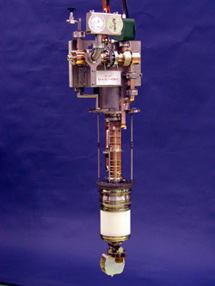A SLAC XL4 Klystron. (Photo courtesy of the SLAC Klystron Department.)
From today's issue of SLAC Today:
The word "X-band" evokes a certain James Bond-style stealth. Outside of the movie theater, that's true to a certain extent; rumor has it that the name for this portion of the electromagnetic spectrum—ranging from 8 to 12 gigahertz—came about during World War II, when radar system designers did not want enemies to figure out what frequencies they were using.
Nowadays, uses for X-band waves reach far beyond radar and communications. Emerging as a new option for powering linear accelerators, this segment of the electromagnetic spectrum could have applications in accelerators for physics as well as industrial accelerators for use in medicine, plastics and beyond. X-band waves allow for more compact and less costly accelerators, making them appealing to industries that want to use acceleration technology but have limited space and resources.
Now, physicists Tor Raubenheimer and Chris Adolphsen are looking to revitalize SLAC National Accelerator Laboratory's X-band technology program. In early March, SLAC hosted an X-band workshop aimed at enticing users with the possibilities and rounding up commercial interest.
"We think this has a lot of potential applications, if the workshop is any indication," Raubenheimer said, adding that there is a lot of interest from industry.
In accelerators, particles ride on the crests of electromagnetic waves. The important difference between types of waves—such as S-band, L-band and X-band—is their frequency, or the number of waves per second. In comparison to S-band, an X-band wave is four times shorter and thus occurs four times as often in the same time period. The higher frequency allows for a higher gradient, which is the amount of energy a particle gains in a specified distance. The new X-band technology can generate gradients around 100 megavolts per meter, six times that of the S-band systems driving SLAC's existing linear accelerator.
Since the 1980s, SLAC physicists have been interested in developing higher-frequency technology for high-energy linear colliders, and chose to pursue an X-band frequency of 11.424 gigahertz—four times that of the current SLAC linac. In 2004, the International Linear Collider collaboration settled on another option for the next big linear collider -- the superconducting L-band, at 1.3 gigahertz -- and much of the X-band research at SLAC slowed.
The advantage to using the X-band frequency range to accelerate particles has less to do with new research options than simple economics. The higher frequency allows scientists to accomplish similar objectives, but in a smaller, less costly accelerator. Use of X-band technology could cut the capital investment of building a new accelerator in half.
"Multiple users are beginning to realize this technology would be ideally suited to their applications," Raubenheimer said.
Raubenheimer and Adolphsen are currently collaborating with Lawrence Livermore National Laboratory on the MEGa-Ray Project. This project will generate intense gamma rays from an X-band accelerator and high-intensity laser. Useful for nuclear waste imaging, this technology could also have widespread applications in security and many other areas.
Only recently has high gradient X-band radiofrequency become a realistic option for accelerators. Since 2004, physicists have made leaps and bounds with X-band technology, particularly with accelerator structures—doubling the available gradient from 50 to 100 Megavolts/meter.
"The issue was that although there were much improved structures, there were no appropriate, reliable radiofrequency power sources to drive," said physicist Vinod Bharadwaj of SLAC's Acclerator Research Division. To address this problem, the division is working on a proposal to develop and industrialize these power sources and hardware, and hopes to get funding in 2011.
In the meantime, SLAC will continue to work on other aspects of X-band technology, which has a handful of additional, more niche applications. This electromagnetic range is also useful for fine-tuning and manipulating the accelerator beam.
Julie Karceski







